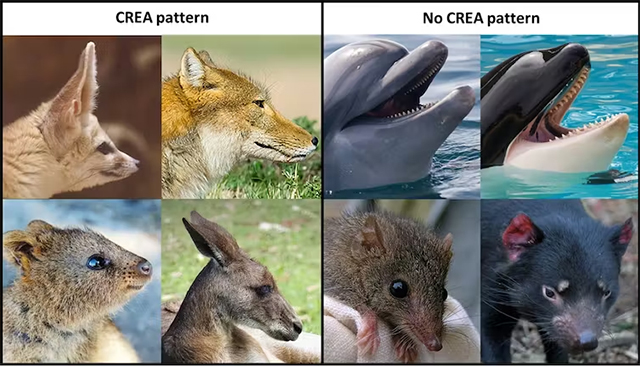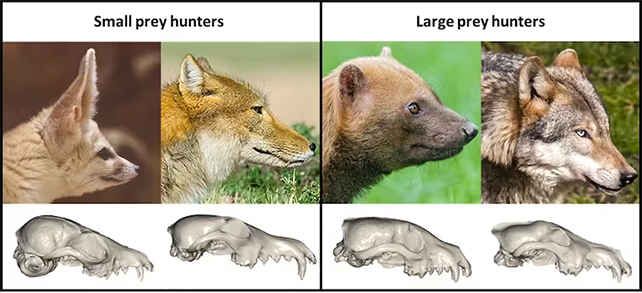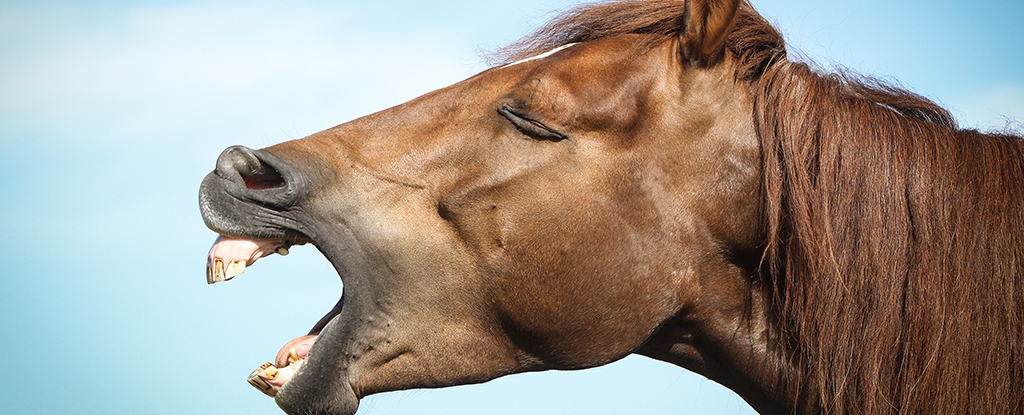A horse walks into a bar and the bartender asks, “why the long face”? It’s one of the oldest puns in the book, and there’s no shortage of entertaining answers.
With our new review we add our own scientific explanation: horses, and many other large mammals, have long faces simply because they can afford to.
While it might seem an unlikely topic, “why the long face?” is an important question in studies of mammal evolution. That’s because long-faced mammals don’t occur at random. Rather, a longer face often coincides with a larger body size within individual animal groups.
We call this effect “craniofacial evolutionary allometry”, or CREA. It has been observed in wildly different mammalian groups such as cats, rodents, deer, kangaroos and some monkeys. You can see CREA in action if you compare a sheep’s face with a cow’s, or a small deer’s with a gigantic moose’s.
Given how common it is, there’s a surprising lack of explanations for CREA. One suggestion is the CREA pattern might be an innate part of skull development, wherein a mammal’s face automatically becomes longer as the animal grows.
The snag with this explanation is the many cases where the CREA pattern doesn’t exist, or is reversed.
Tasmanian devils, sea otters and orcas are all larger than most of their relatives, but have shorter faces. Meanwhile, long-nosed potoroos, honey possums and nectar-feeding bats are small in size but long in the face.
Clearly, a mammal’s large body size doesn’t always dictate its face must be long.

Then why is CREA so common?
We propose the answer lies in the simple biomechanics of how species use their faces to eat. One important observation is that closely related animals tend to eat similar foods.
For example, sheep eat the same grass as cows. However, because sheep are smaller overall, they have to bite harder with their jaws, jaw muscles and teeth (which make up most of their face).
As it happens, shorter faces are more efficient at biting hard. This is because of the smaller distance between the jaw muscles and the teeth. Barbecue tongs work the same way: the closer your hand is to the tips, the stronger your grip on a steak.
The existence of short faces is therefore easily explained. The trickier question is: if short faces are so good at biting hard, why do large mammals have longer faces?
The answer lies in the fact that larger animals naturally have bigger muscles and can bite more easily. They work less hard at biting compared with their smaller relatives.
In other words, larger mammals can “afford” to have longer skulls, which are known to be advantageous in a range of situations. In herbivores, longer faces make it easier to reach more leaves or take larger mouthfuls. In carnivores, a longer face can fit larger fangs in the mouth or help jaws snap shut faster.
An explanation for ‘outliers’
Our proposed explanation for CREA also explains exceptions to it, which almost always involve a big change in diet. The dog family is a great example. This group includes small-prey hunters such as foxes, and large-prey hunters such as wolves.
Both small-prey and large-prey hunters follow CREA within their diet groups. In other words, larger individuals within a group of foxes will have longer faces.
However, even though wolves tend to be larger than foxes, they still have shorter faces than the largest foxes. We suggest this is because they hunt larger prey, and therefore require a stronger bite.

Our explanation also applies in the opposite scenario. For example, honey possums and potoroos can “afford” to have longer faces than their larger relatives because they eat softer foods. A longer face may allow them to hold a longer tongue, or easily sniff through soil for food.
We’d also expect exceptions where a species does not use its snout for capturing or breaking down food. Humans, with their strikingly short faces relative to a huge braincase, are a great example. Our species doesn’t use its face for acquiring food at all; our hands, tools and ability to cook do the job for us.
The long and short of it
Our work provides a new framework for understanding face length across different groups of mammals. We could even use it to gain important insight into the feeding habits of Australia’s extinct megafauna.
As for the horse, the next time the bartender asks “why the long face?” – it ought to reply “because I can afford it” and leave a generous tip.![]()
Vera Weisbecker, Associate Professor, Flinders University; Emma Sherratt, Senior Research Fellow in Ecology & Evolutionary Biology, University of Adelaide, and Rex Mitchell, Postdoctoral Fellow, Flinders University
This article is republished from The Conversation under a Creative Commons license. Read the original article.





